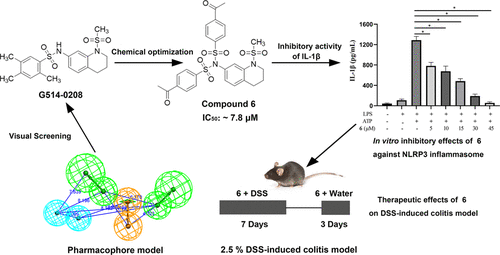当前位置:
X-MOL 学术
›
J. Med. Chem.
›
论文详情
Our official English website, www.x-mol.net, welcomes your feedback! (Note: you will need to create a separate account there.)
Development of Novel Tetrahydroquinoline Inhibitors of NLRP3 Inflammasome for Potential Treatment of DSS-Induced Mouse Colitis
Journal of Medicinal Chemistry ( IF 7.3 ) Pub Date : 2020-12-17 , DOI: 10.1021/acs.jmedchem.0c01924 Zhen Dai 1, 2 , Xiao-yi Chen 1, 2 , Lu-yan An 1, 2 , Cui-cui Li 1, 2 , Ni Zhao 1, 2 , Fan Yang 1, 2 , Song-tao You 1, 2 , Chen-zhi Hou 1, 2 , Kan Li 1, 2 , Cheng Jiang 1, 2 , Qi-dong You 1 , Bin Di 1, 2 , Li-li Xu 1, 2
Journal of Medicinal Chemistry ( IF 7.3 ) Pub Date : 2020-12-17 , DOI: 10.1021/acs.jmedchem.0c01924 Zhen Dai 1, 2 , Xiao-yi Chen 1, 2 , Lu-yan An 1, 2 , Cui-cui Li 1, 2 , Ni Zhao 1, 2 , Fan Yang 1, 2 , Song-tao You 1, 2 , Chen-zhi Hou 1, 2 , Kan Li 1, 2 , Cheng Jiang 1, 2 , Qi-dong You 1 , Bin Di 1, 2 , Li-li Xu 1, 2
Affiliation

|
The NLRP3 inflammasome is a critical component of innate immunity, which defends internal and external threats. However, inappropriate activation of the NLRP3 inflammasome induces various human diseases. In this study, we discovered and synthesized a series of tetrahydroquinoline inhibitors of NLRP3 inflammasome. Among these analogues, compound 6 exhibited optimal NLRP3 inhibitory activity. In vitro studies indicated that compound 6 directly bound to the NACHT domain of NLRP3 but not to protein pyrin domain (PYD) or LRR domain, inhibited NLRP3 ATPase activity, and blocked ASC oligomerization, thereby inhibiting NLRP3 inflammasome assembly and activation. Compound 6 specifically inhibited the NLRP3 inflammasome activation, but had no effect on the activation of NLRC4 or AIM2 inflammasomes. Furthermore, in the dextran sulfate sodium (DSS)-induced colitis mouse model, compound 6 exhibited significant anti-inflammatory activity through inhibiting NLRP3 inflammasome in vivo. Therefore, our study provides a potent NLRP3 inflammasome inhibitor, which deserves further structural optimization as a novel therapeutic candidate for NLRP3-driven diseases.
中文翻译:

新型NLRP3炎性小体的四氢喹啉抑制剂的开发,用于潜在治疗DSS诱导的小鼠结肠炎
NLRP3炎性小体是先天免疫的重要组成部分,可防御内部和外部威胁。但是,NLRP3炎性体的不适当活化会诱发各种人类疾病。在这项研究中,我们发现并合成了一系列NLRP3炎性小体的四氢喹啉抑制剂。在这些类似物中,化合物6表现出最佳的NLRP3抑制活性。体外研究表明,化合物6直接与NLRP3的NACHT结构域结合,但不与蛋白吡喃结构域(PYD)或LRR结构域结合,抑制NLRP3 ATPase活性,并阻止ASC寡聚,从而抑制NLRP3炎症小体的组装和活化。化合物6特异性抑制NLRP3炎性小体的激活,但对NLRC4或AIM2炎性小体的激活没有影响。此外,在葡聚糖硫酸钠(DSS)诱导的结肠炎小鼠模型中,化合物6通过抑制NLRP3炎性体在体内表现出显着的抗炎活性。因此,我们的研究提供了一种有效的NLRP3炎性体抑制剂,作为NLRP3驱动疾病的新型治疗候选药物,值得进一步的结构优化。
更新日期:2021-01-14
中文翻译:

新型NLRP3炎性小体的四氢喹啉抑制剂的开发,用于潜在治疗DSS诱导的小鼠结肠炎
NLRP3炎性小体是先天免疫的重要组成部分,可防御内部和外部威胁。但是,NLRP3炎性体的不适当活化会诱发各种人类疾病。在这项研究中,我们发现并合成了一系列NLRP3炎性小体的四氢喹啉抑制剂。在这些类似物中,化合物6表现出最佳的NLRP3抑制活性。体外研究表明,化合物6直接与NLRP3的NACHT结构域结合,但不与蛋白吡喃结构域(PYD)或LRR结构域结合,抑制NLRP3 ATPase活性,并阻止ASC寡聚,从而抑制NLRP3炎症小体的组装和活化。化合物6特异性抑制NLRP3炎性小体的激活,但对NLRC4或AIM2炎性小体的激活没有影响。此外,在葡聚糖硫酸钠(DSS)诱导的结肠炎小鼠模型中,化合物6通过抑制NLRP3炎性体在体内表现出显着的抗炎活性。因此,我们的研究提供了一种有效的NLRP3炎性体抑制剂,作为NLRP3驱动疾病的新型治疗候选药物,值得进一步的结构优化。


























 京公网安备 11010802027423号
京公网安备 11010802027423号